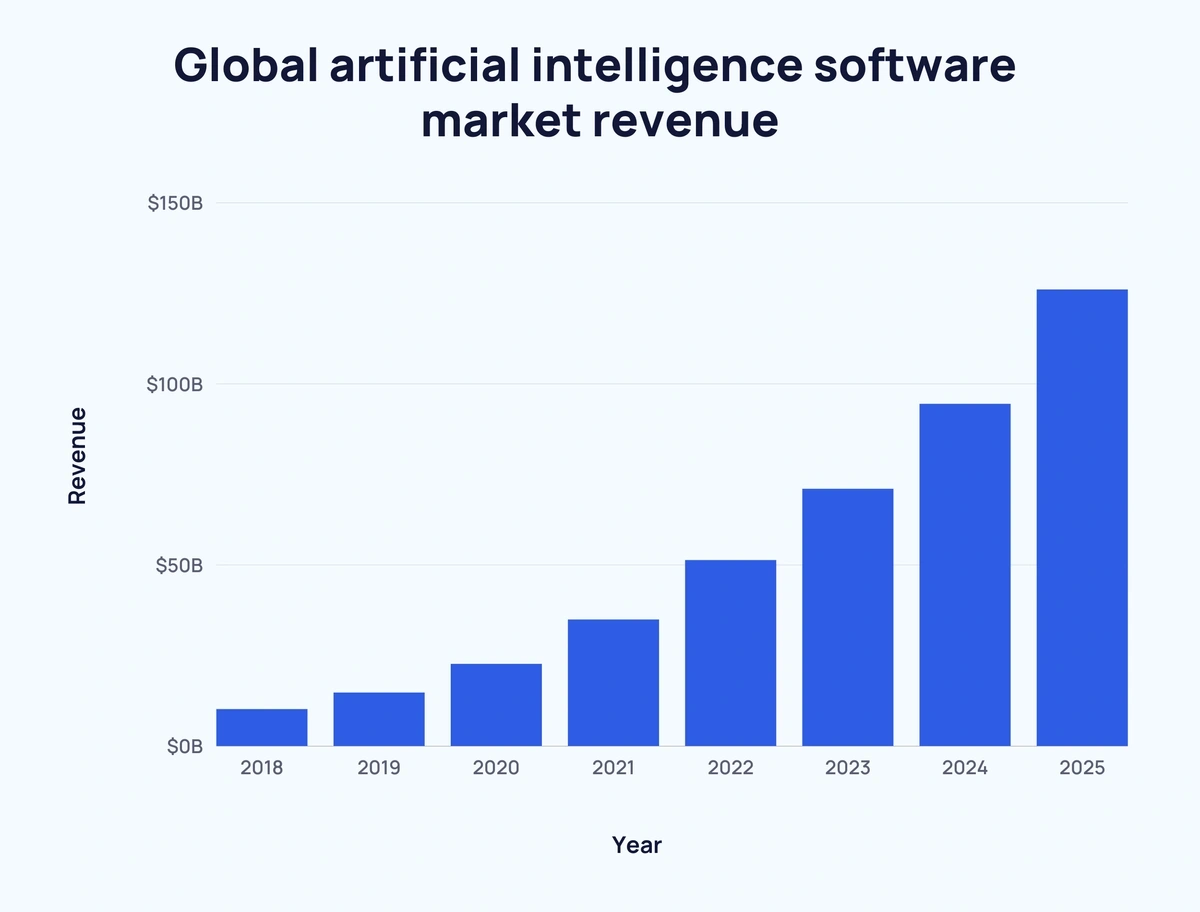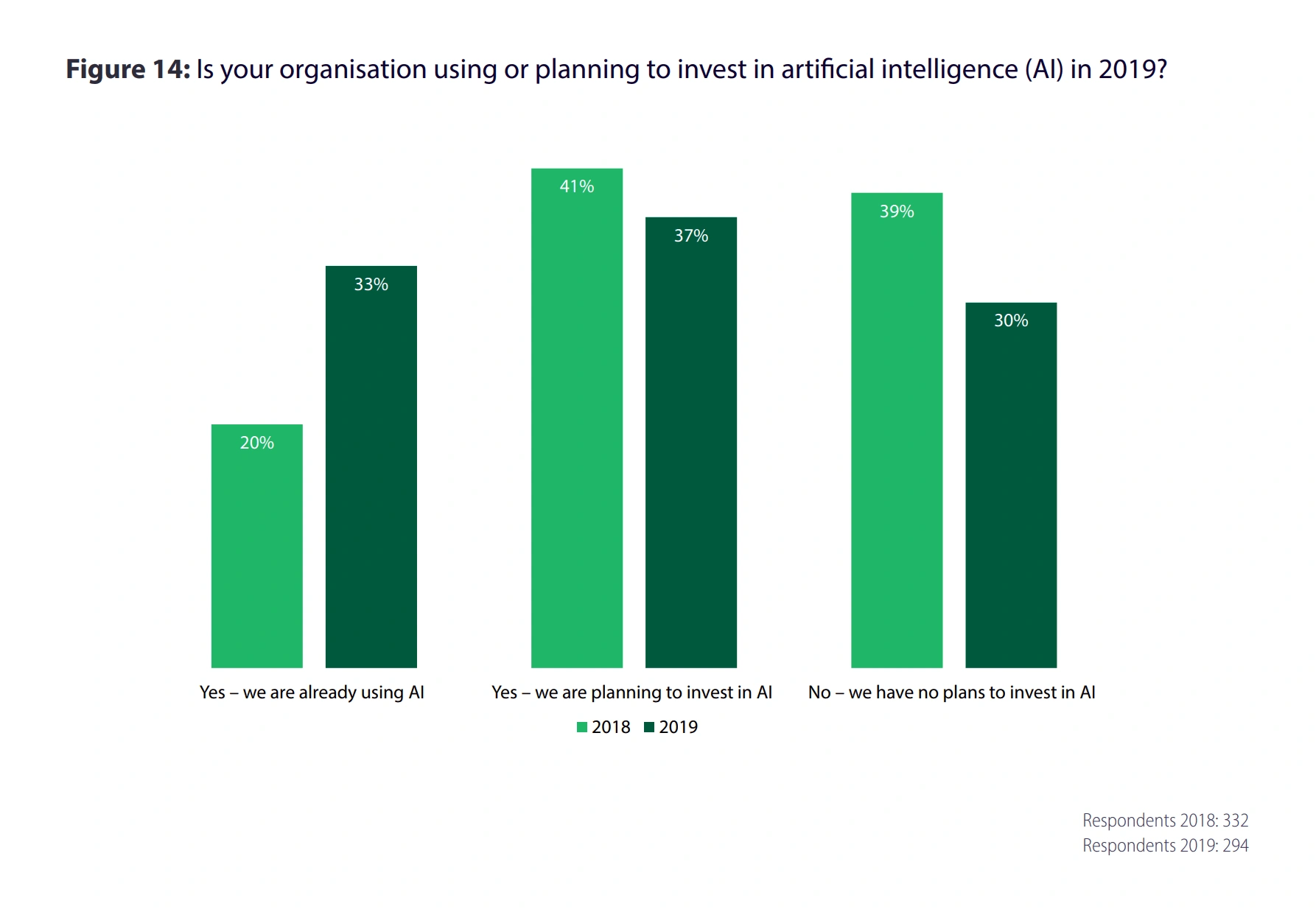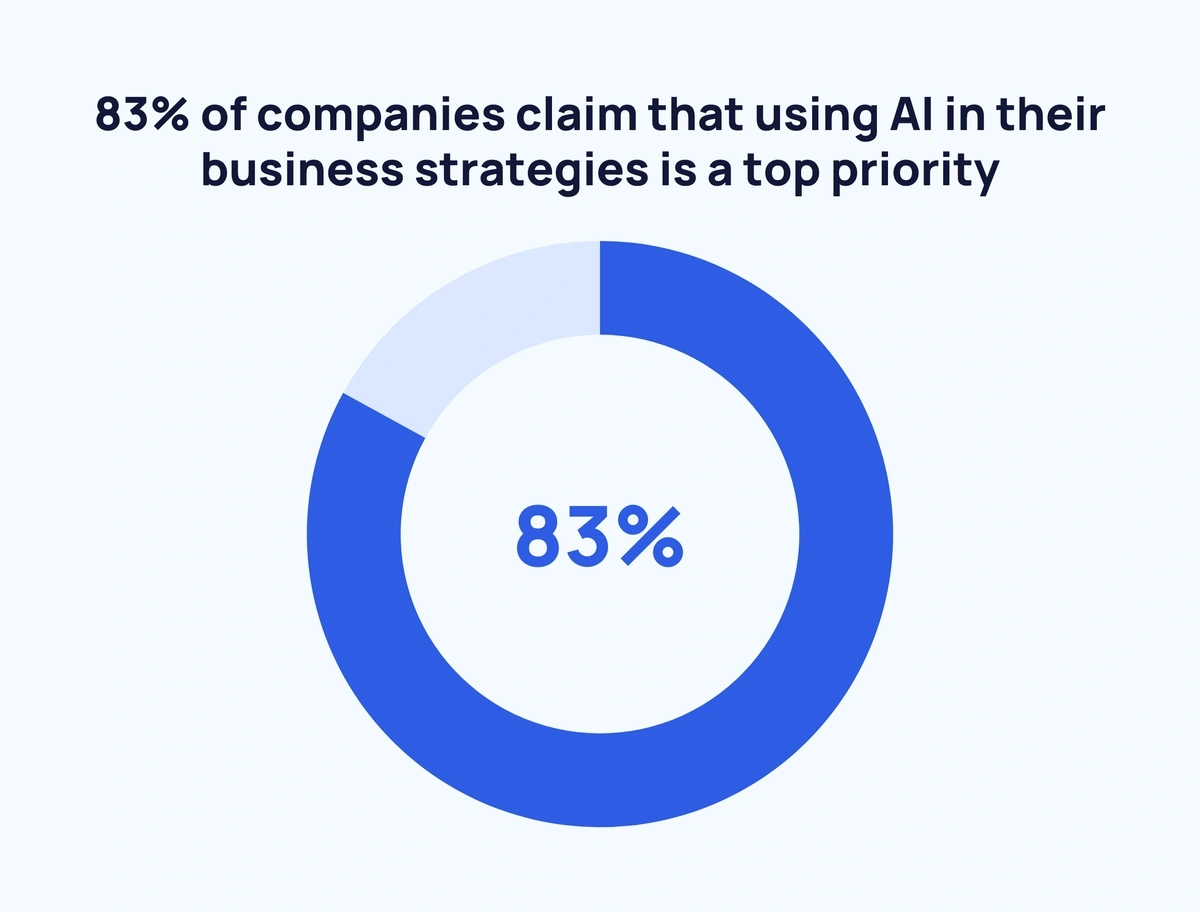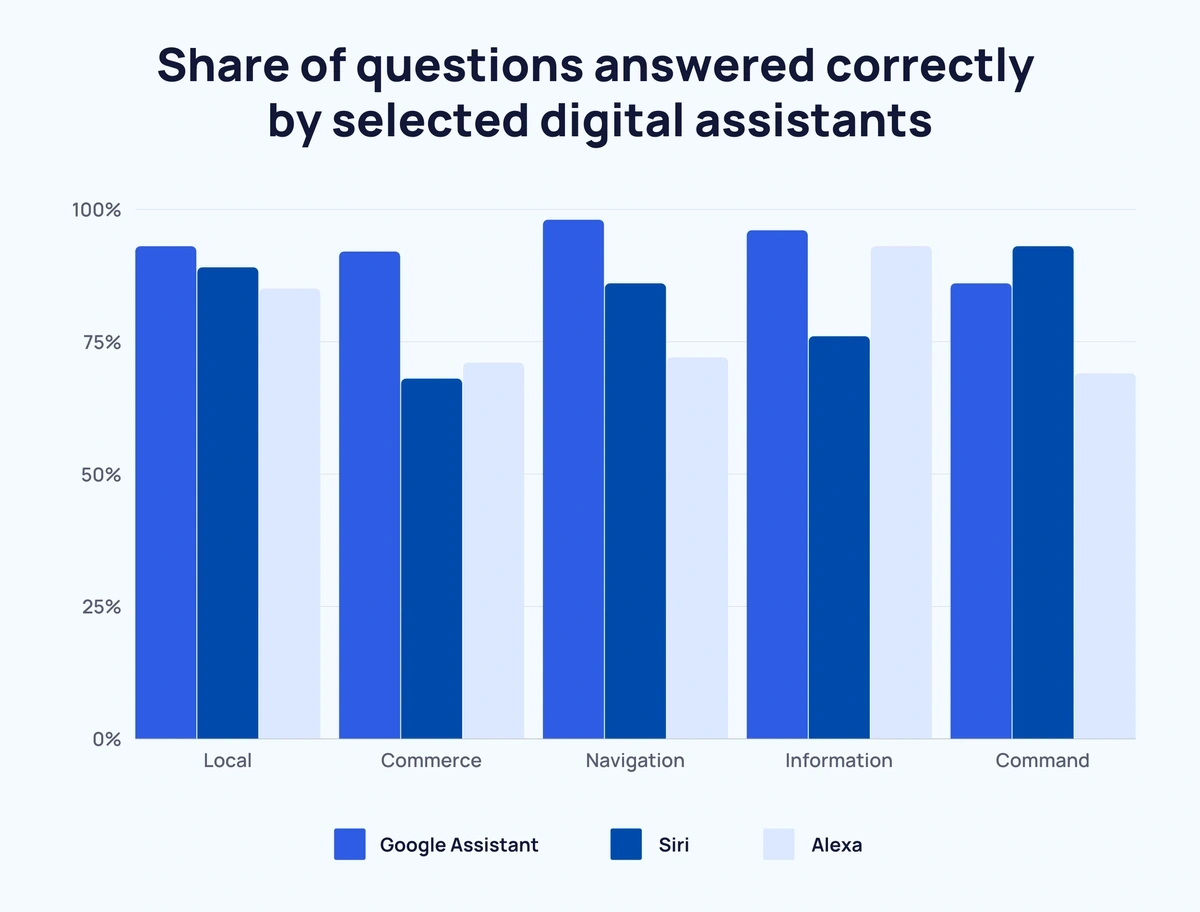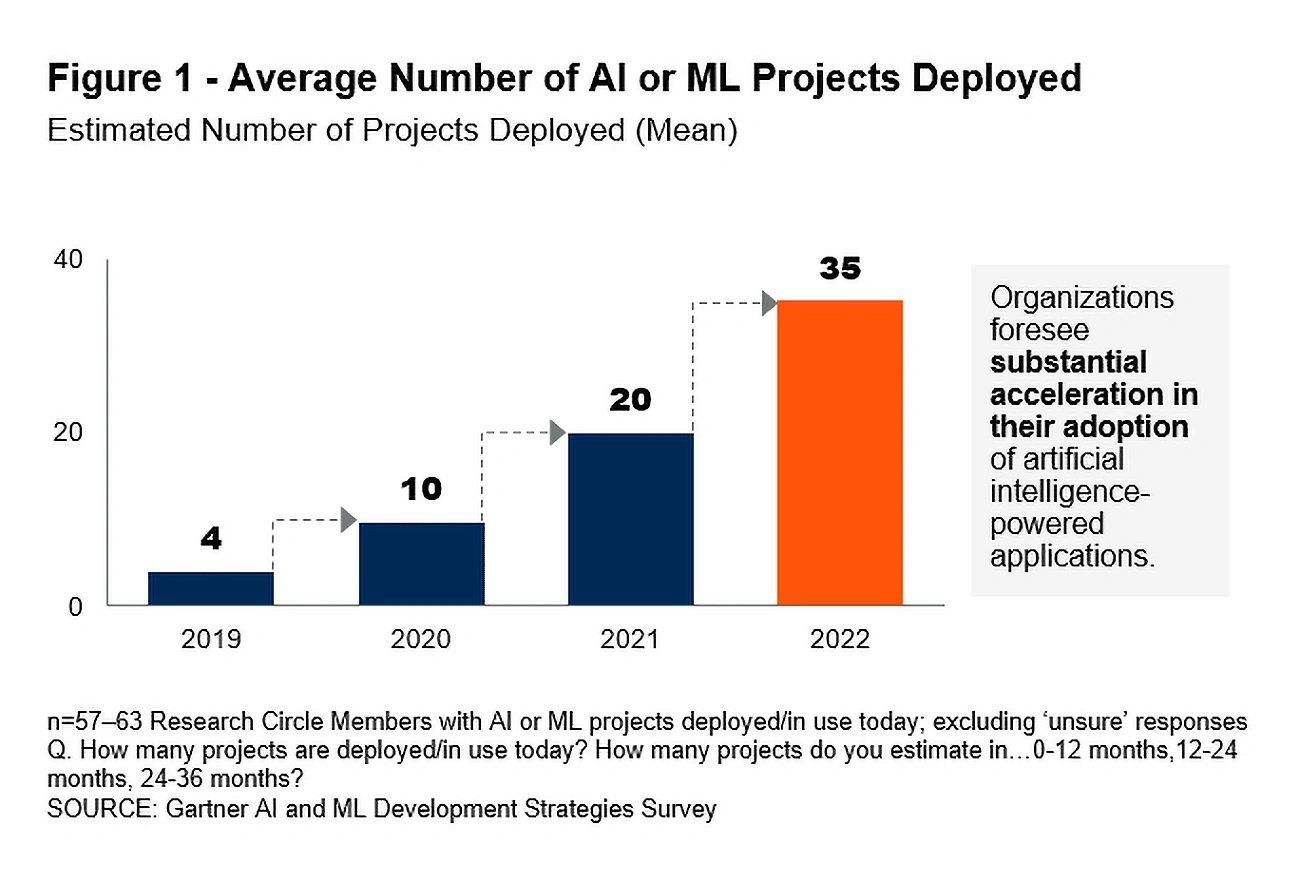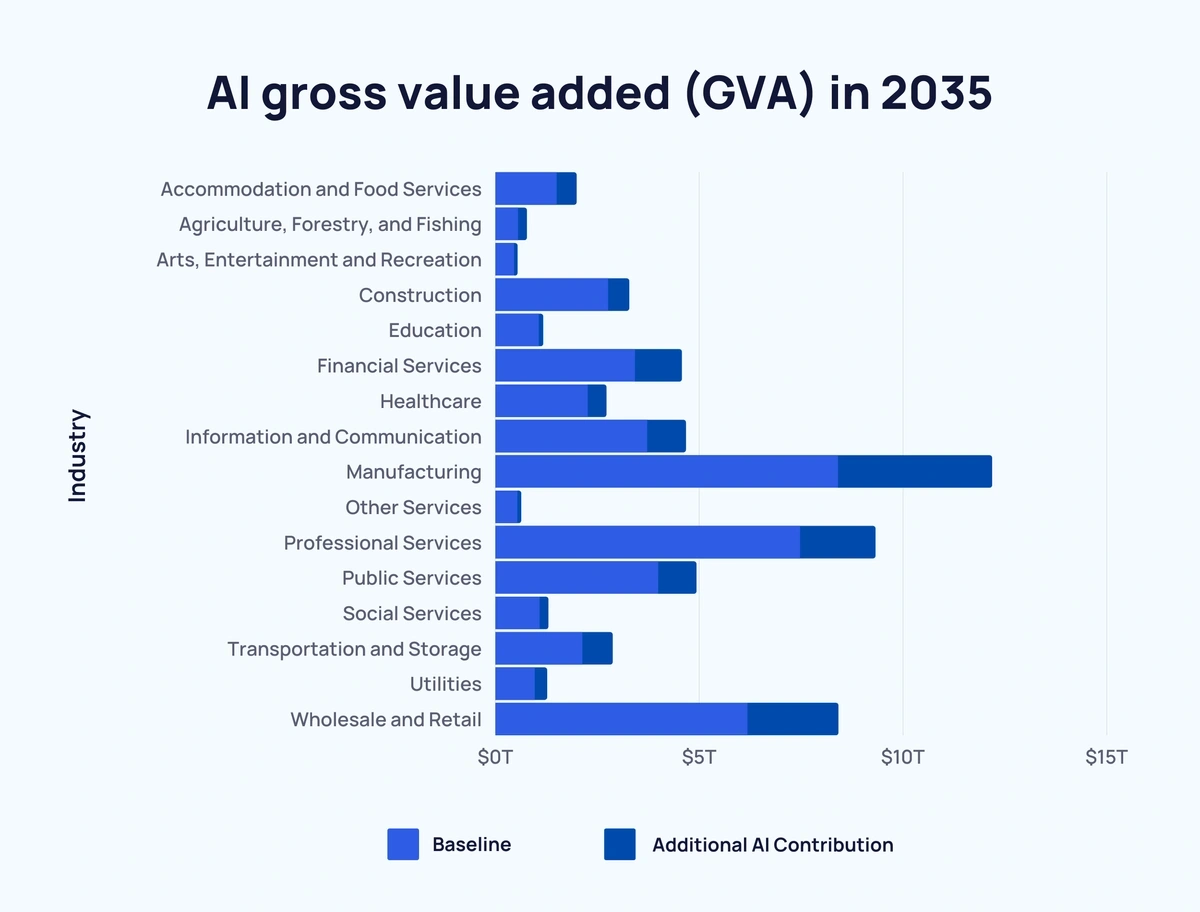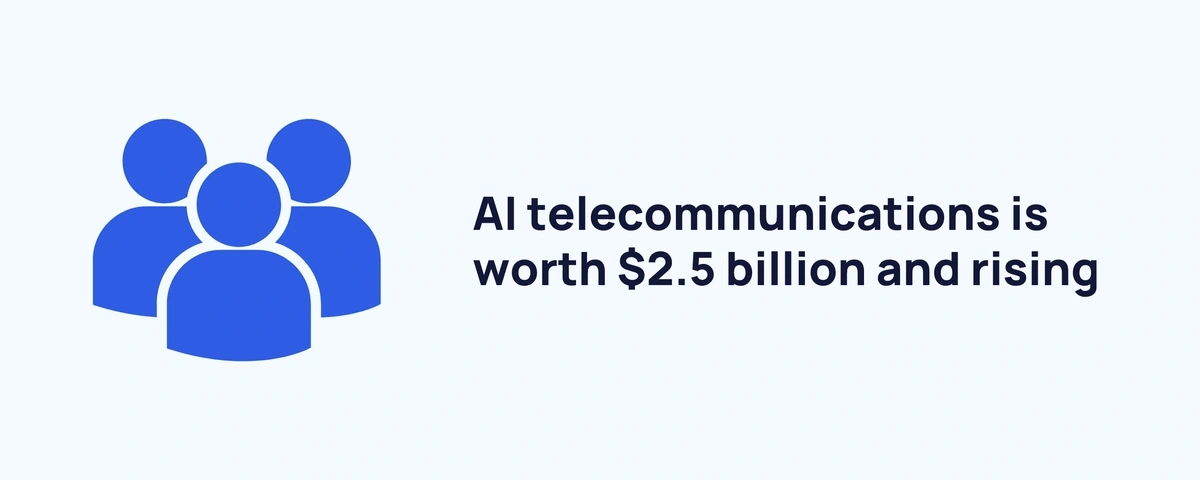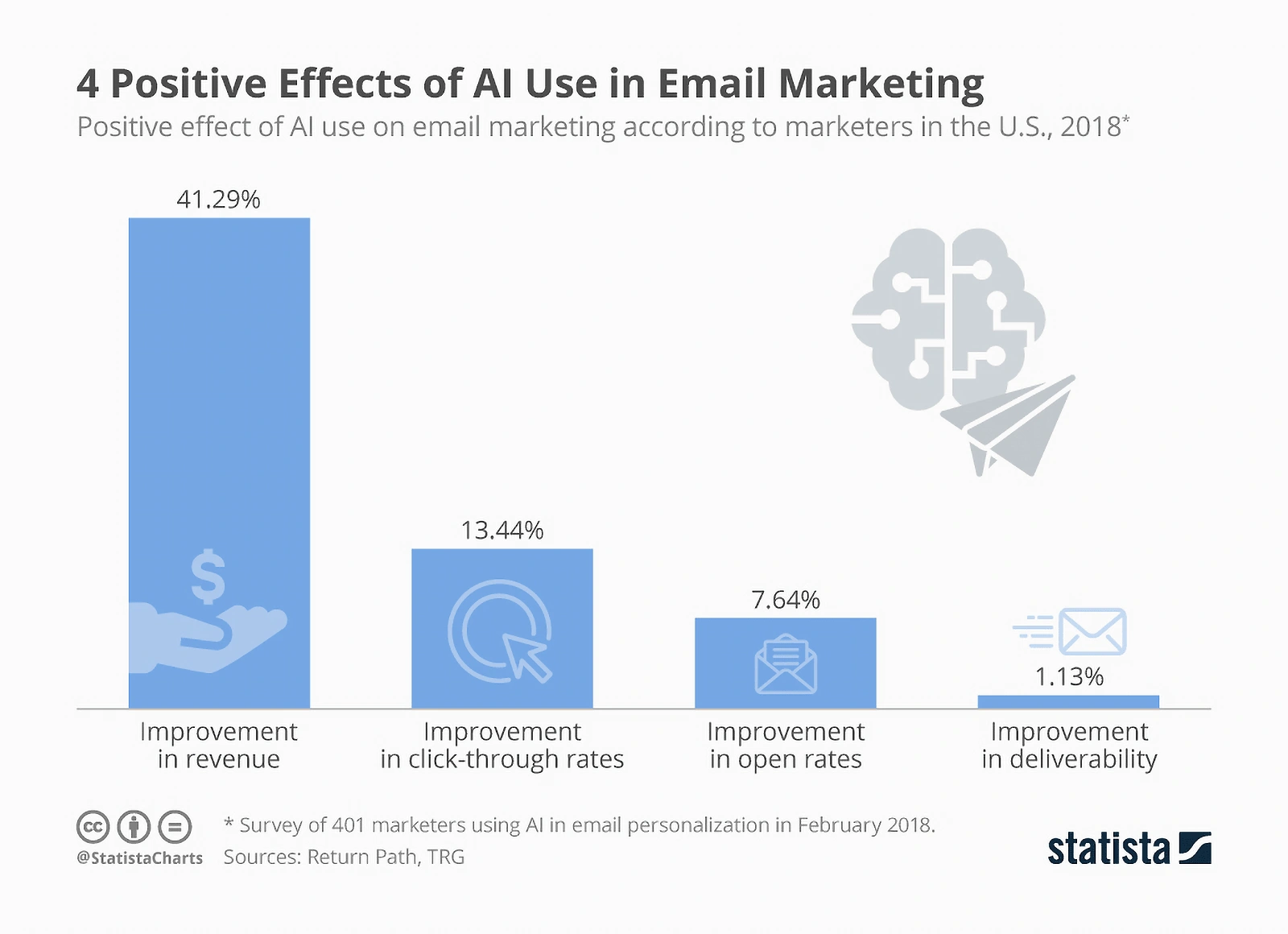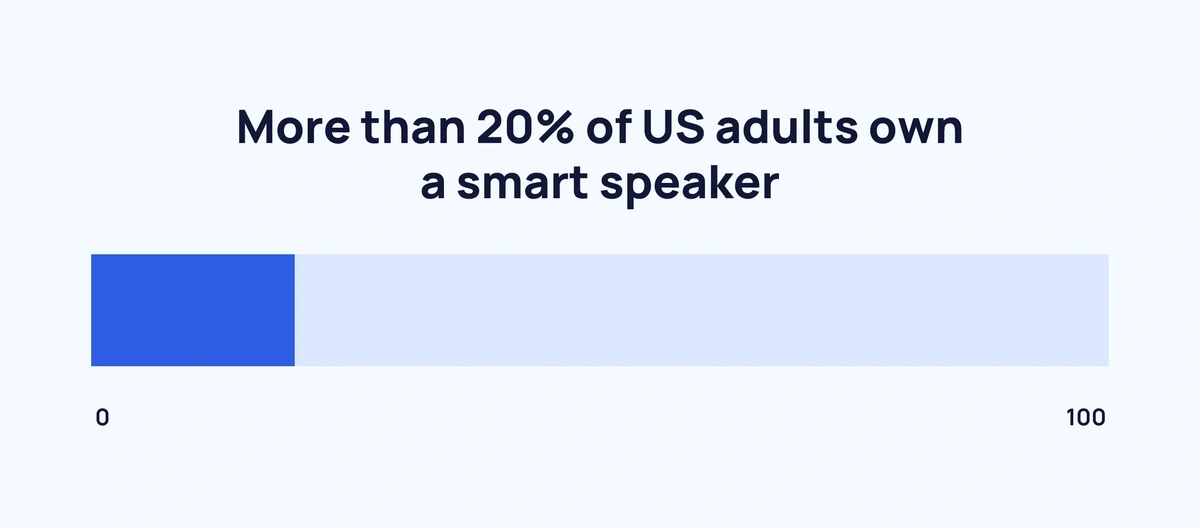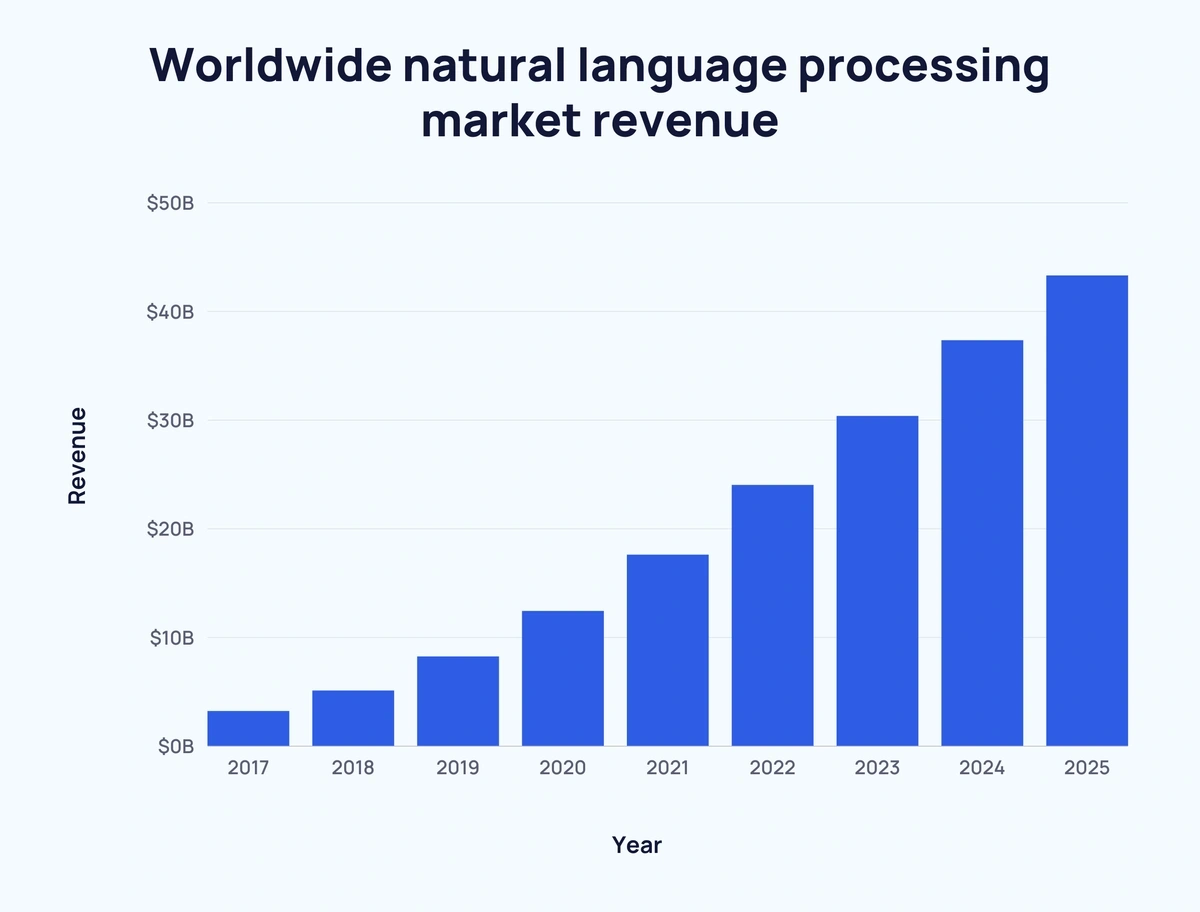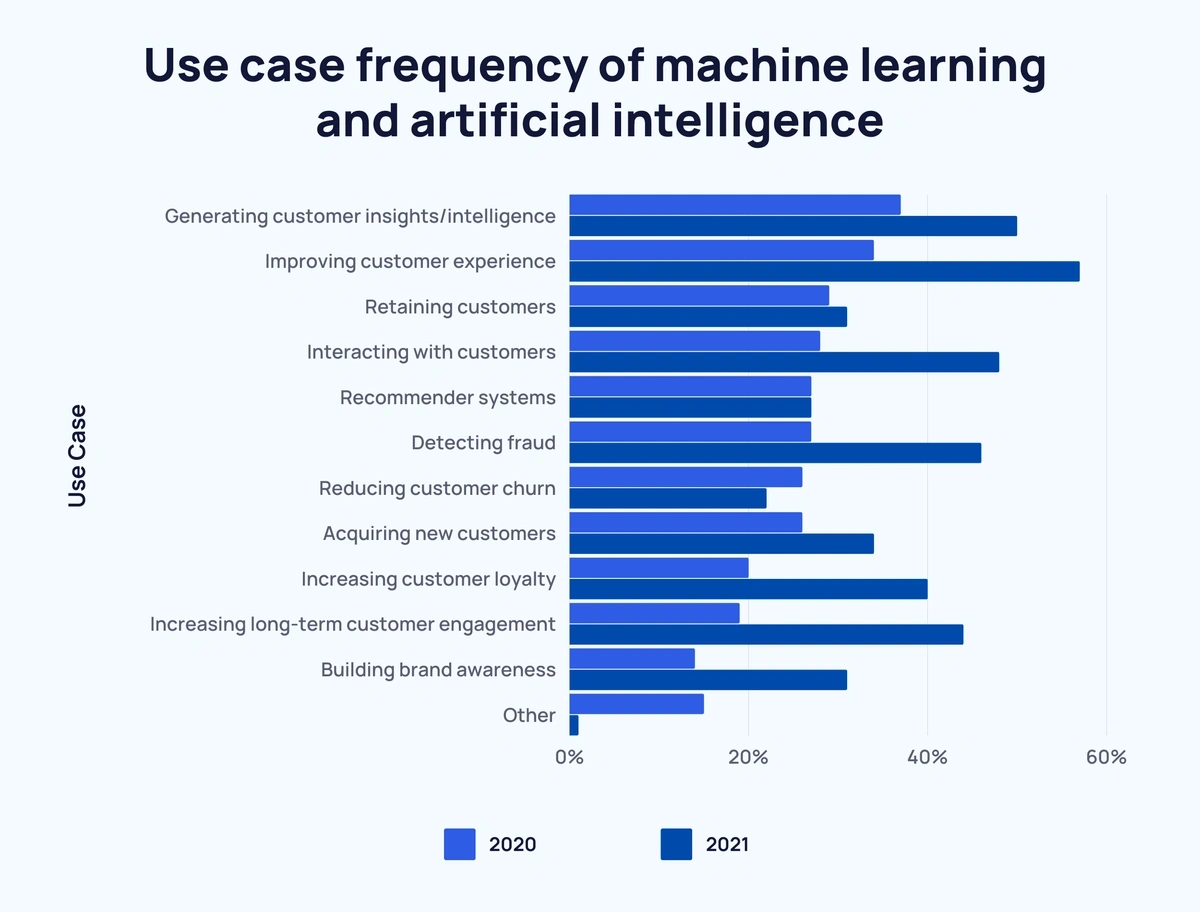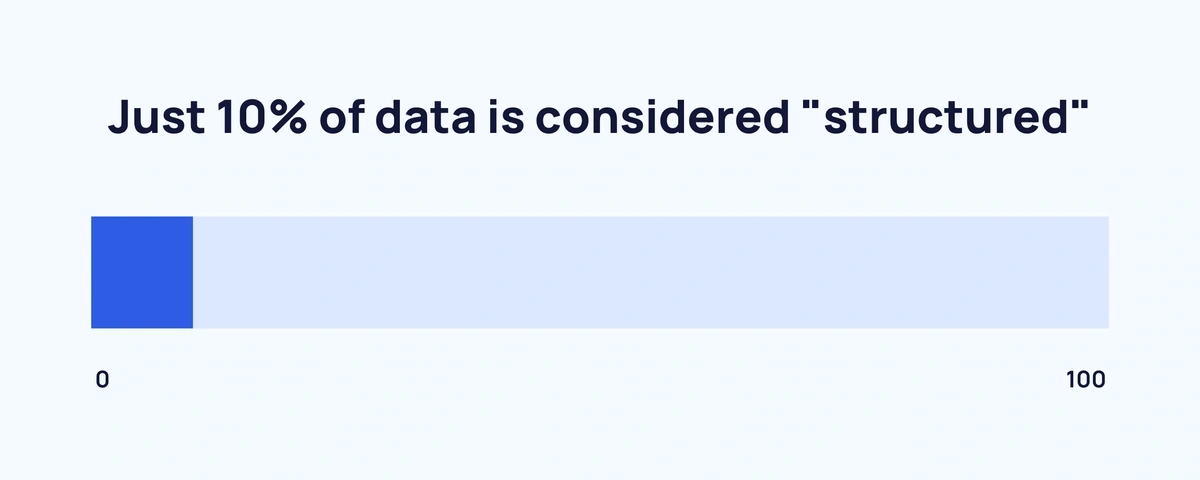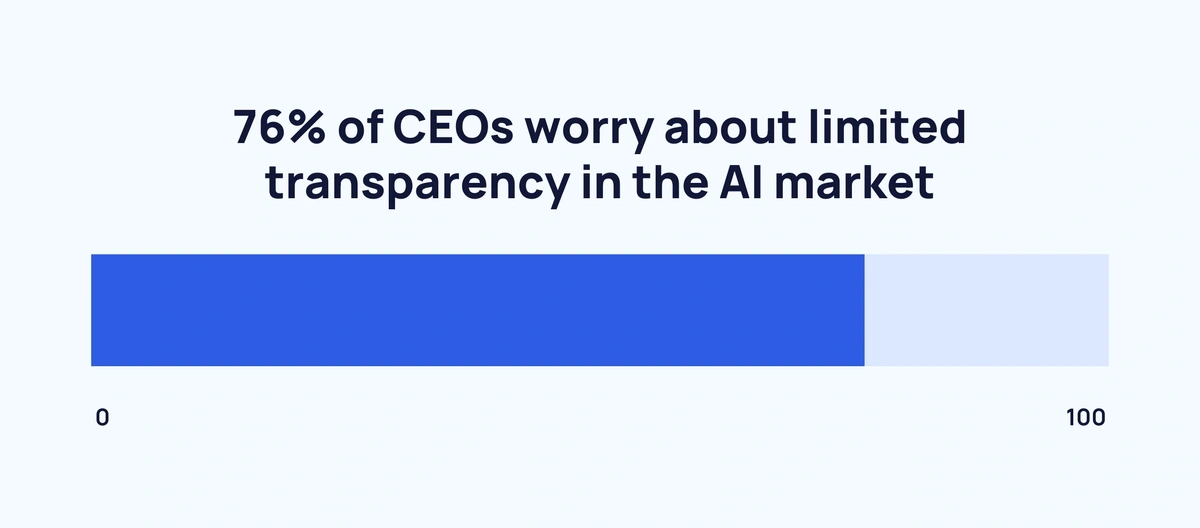
57 NEW Artificial Intelligence Statistics (Nov 2024)
This is a list of up-to-date artificial intelligence stats for 2024.
From ChatGPT to autonomous vehicles, AI is one of the most exciting (and controversial) technology trends happening in the 21st century.
But how big is the AI space? And how quickly is it growing?
In this article, we'll take a closer look at key AI statistics, along with growth projections for the future.
Contents
- Top AI Statistics (Editor's Picks)
- Artificial Intelligence Market Size
- AI Adoption: Artificial Intelligence Growth
- How Businesses Adopt Artificial Intelligence
- AI in Marketing, Customer Service, and Sales Statistics
- AI Replacing Jobs and Employment Statistics
- Where is AI Used Today?
- Popular AI Function Statistics
- AI Challenges & Predictions
Top AI Statistics (Editor's Picks)
- The global AI market is valued at over $196 billion
- AI industry value is projected to increase by over 13x over the next 6 years
- The US AI market is forecast to reach $299.64 billion by 2026
- The AI market is expanding at a CAGR of 38.1% between 2022 to 2030
- By 2025, as many as 97 million people will work in the AI space
- AI market size is expected to grow by at least 120% year-over-year
- 83% of companies claim that AI is a top priority in their business plans
- Netflix makes $1 billion annually from automated personalized recommendations
- 48% of businesses use some form of AI to utilize big data effectively
- 38% of medical providers use computers as part of their diagnosis
Artificial Intelligence Market Size
The AI market is worth around $279 billion (GrandViewResearch)
As of the latest available data, the global AI market is worth $279 billion. That's an increase of around $80 billion since 2023.
This is primarily thanks to increasing practical use cases of AI technology, from content creation to self-driving cars.
The global AI market is expected to reach $1.81 trillion by 2030 (GrandViewResearch)
While the current AI market is sizeable, it's set to grow by over 13x over the next decade or so.
During this forecast period, the AI market is predicted to increase by a CAGR of 37.3%.
The AI software market's global annual revenue stands at around $100 billion (Omdia)
The AI software market's global annual revenue (2018 to 2025):
| Year |
Revenue |
| 2018 |
$10.1 billion |
| 2019* |
$14.69 billion |
| 2020* |
$22.59 billion |
| 2021* |
$34.87 billion |
| 2022* |
$51.27 billion |
| 2023* |
$70.94 billion |
| 2024* |
$94.41 billion |
| 2025* |
$126 billion |
*Projected figures.
ChatGPT reached 1 million users in 5 days (OpenAI)
In late 2022, ChatGPT broke records as the AI platform reached 1 million users in less than a week.
By early 2023, ChatGPT had accumulated over 100 million monthly users.
9 in 10 organizations back AI to give them a competitive edge over rivals (MIT Sloan Management)
One survey found that 87% of global organizations believe that AI technologies will give them a competitive edge.
This equates to an increase of 12% from the previous year.
AI Adoption: Artificial Intelligence Growth
Between 2015 and 2019, the number of businesses utilizing AI services grew by 270% (Gartner, Forbes)
In 2015 just 10% of organizations used or planned to implement AI in the near future.
By 2019, this figure had surged to 37%.
Meanwhile, in the UK, the number of AI companies has increased by 600% over the past decade.
Approximately 7 in 20 organizations use AI (Hostinger)
According to Hostinger Tutorials, 35% of companies use AI services.
Global AI is growing at a CAGR of almost 40% (Grand View Research)
AI's recent rapid growth is unlikely to slow down in the near future.
In fact, global AI adoption by organizations is set to expand at a CAGR of 36.6% between 2024 and 2030.
AI service revenue will have increased by over 6x in the space of 5 years (Omdia)
In 2020, AI services generated approximately $19.4 billion in revenue.
In 2022, the market was estimated to grow to $62.5 billion.
And by 2025, the AI space is forecast to reach $126 billion in annual revenue.
The wearable AI market is expected to reach $180 billion by next year (Global Market Insights)
The success of products like the Apple Watch and Fitbits is set to boost the global wearable AI market value.
By 2025, the market is expected to be valued at $180 billion.
AI tech can increase revenue by over $15 trillion by the end of the decade (PwC)
Some estimates suggest that AI technology could generate $15.7 trillion in revenue by 2030. Boosting the GDP of local economies by an additional 26%.
The AI market is set to grow by 26% in 2025 (Tractica)
The latest available data predicts a lucrative near future for the AI market.
Between 2021 and 2022, the AI market was projected to grow by 47%.
And this upward trajectory was forecast to continue year-over-year – increasing by at least 26% each year until 2025:
| Year |
Year-Over-Year Growth |
| 2019 |
54% |
| 2020 |
54% |
| 2021 |
54% |
| 2022 |
47% |
| 2023 |
38% |
| 2024 |
33% |
| 2025 |
26% |
Worldwide AI chip revenue will surpass $80 billion in the next few years (The Insight Partners)
The latest data shows that global AI chip revenue is set to reach $83.25 billion by 2027.
Almost 100 million will be working in the AI space by next year (We Forum)
If the projections about growth in the AI space come to fruition, further manpower will be required.
By 2025, approximately 97 million people will be necessary to fill the work demands of the surging industry.
By 2026, business analysts estimated that the US AI market size will reach nearly $300 billion (PR Newswire)
As dependency on human intelligence decreases, this figure is set to rise further.
By 2026, the US AI space will be worth a reported $299.64 billion. Between 2021-2028 That's a predicted CAGR of 40.2% between 2021 and 2028.
China will account for more than one-quarter of the global AI market by the end of the decade (GlobeNewsWire)
The world's second-largest economy, China, will have an AI industry worth around $40.6 billion by 2026. Growing at a CAGR of 39.1%.
By 2030, China will account for 26.1% of the global AI market share.
How Businesses Adopt Artificial Intelligence
Around 4 in 5 companies deem AI to be a top priority in their business strategy (Forbes)
A whopping 83% of companies claim that using AI in their business strategies is a top priority.
Automated emails and chatbots are two of the most common uses of AI in everyday business communications.
Here's a look at current company usage of AI:
| AI Usage | Percentage |
| Don’t use AI currently but are looking into it | 7% |
| Have tested a few proofs of concepts with limited success | 14% |
| We have a few promising proofs of concepts and are looking to scale | 21% |
| We have processes that are fully enabled by AI with widespread adoption | 25% |
| We have started implementing with limited AI use cases. | 33% |
80% of retail executives expect their businesses to adopt AI automation by 2025 (Analytics Insight)
The vast majority of surveyed retail executives believe their company will utilize AI automation within the next three years.
Around 17 in 20 CEOs claimed AI would be "mainstream technology" in their company in 2021 (PWC)
86% of CEOs agree that AI and business go hand-in-hand since AI is mainstream technology in their offices.
AI is expected to improve employee productivity by 40% (PWC)
Data suggests that AI has the potential to boost employee productivity by approximately 40% by 2035.
Netflix's recommendations technology is worth $1 billion in revenue annually (Business Insider)
Many consumers will likely agree that Netflix's use of AI is one of their biggest selling points. The streaming platform utilizes AI to personalize recommendations and tailor them to viewers' interests.
Tech companies that invest in AI often significantly increase their revenue as algorithms can keep the consumer constantly returning for more.
Data shows that the top voice assistant by accuracy is Google Assistant (Loup Ventures)
Google Assistant outranks its voice assistant competitors, such as Apple Inc.'s Siri and Microsoft's Cortana, with an accuracy record of 98% in navigation.
| Type of question | Google Assistant | Siri | Alexa |
| Local |
93% |
89% |
85% |
| Commerce |
92% |
68% |
71% |
| Navigation |
98% |
86% |
72% |
| Information |
96% |
76% |
93% |
| Command |
86% |
93% |
69% |
More than half of telecommunications organizations use chatbots (Gartner)
52% of telecommunications organizations utilize chatbots to increase their overall productivity.
Recent data indicates a substantial acceleration in the adoption of AI-powered applications (Gartner)
One key AI application in business is providing personalized product recommendations via consumer behavior forecasting and targeted advertising.
Pop-up marketing ads and chatbots are each examples of AI operations.
Automation usually translates to less waiting time for customers.
Nearly half of all businesses use some form of machine learning, data analysis, or AI (O'REILLY)
To maintain the accuracy of their data, 48% of businesses use machine learning (ML), data analysis, and AI tools.
The manufacturing industry stands to gain $3.78 trillion from AI by 2035 (Accenture)
The AI industry has a foothold in various business functions, from cloud computing for datasets to streamlining company decision-making.
Industry verticals utilizing AI technology include tech-related sales, insurance, banking, telecom, healthcare, manufacturing, retail, and marketing to name a few.
| Industry | Baseline | Additional AI Contribution |
| Accommodation and Food Services |
$1.5 trillion |
$489 billion |
| Agriculture, Forestry, and Fishing |
$554 billion |
$215 billion |
| Arts, Entertainment and Recreation |
$453 billion |
$87 billion |
| Construction |
$2.76 trillion |
$520 billion |
| Education |
$1.06 trillion |
$109 billion |
| Financial Services |
$3.42 trillion |
$1.15 trillion |
| Healthcare |
$2.26 trillion |
$461 billion |
| Information and Communication |
$3.72 trillion |
$951 billion |
| Manufacturing |
$8.4 trillion |
$3.78 trillion |
| Other Services |
$535 billion |
$95 billion |
| Professional Services |
$7.47 trillion |
$1.85 trillion |
| Public Services |
$3.99 trillion |
$939 billion |
| Social Services |
$1.08 trillion |
$216 billion |
| Transportation and Storage |
$2.13 trillion |
$744 billion |
| Utilities |
$962 billion |
$304 billion |
| Wholesale and Retail |
$6.18 trillion |
$2.23 trillion |
AI-powered self-driving vehicles gross more than $170 billion in annual revenue worldwide (MarketWatch)
The self-driving car market is proving to be more than a novelty niche by grossing $173 billion in global revenue.
Just 7% of people trust chatbots when making a claim (Accenture)
The prevalence of chatbots may be increasing but they still have a long way to go.
Just under 1 in 10 people (7%) trust chatbots when making a claim.
A stark difference from the 49% that trust human advisors.
AI tech is expected to increase banking industry revenue by $1 billion in the next three years (Accenture)
By 2035, AI technology will add $1 billion to the banking industry.
According to the latest data, the AI telecommunications market is worth $2.5 billion (Markets and Markets)
As of 2022, the telecommunications AI market is worth approximately $2.5 billion.
Growing at a CAGR of 46.8% during the forecast period of 2016-2022.
Around 2 in 5 medical professionals now use computer systems to aid diagnosis (Gartner)
38% of medical providers use computer systems as their diagnosis assistants.
AI is helping manufacturing companies outperform competitors (Microsoft)
Manufacturing businesses that utilize AI are performing 12% better than businesses that continue to use traditional methods only.
19 in every 20 customer interactions will be AI-assisted by 2025 (AI Business)
In the next few years, the retail industry will be able to relinquish much of its communication to AI.
In fact, over 95% of online and telephone communications will utilize AI technology.
4 in 5 marketers predicted that AI would revolutionize marketing by 2020 (Demandbase)
80% of marketers believe that AI technology is not a trend, but a revolution that will revitalize the way in which all industries approach their work.
AI in Marketing, Customer Service, and Sales Statistics
Marketing and sales departments prioritize AI and ML for market revenue success 40% more than other industry departments (Forbes)
AI marketing companies, customer service roles, and sales departments rely on process automation to increase their market revenue share.
Artificial intelligence is a solution for overworked customer-facing roles.
AI algorithms increase leads by as much as 50% (Harvard Business Review)
AI algorithms reveal data on which products generate the highest profit margins and offer valuable insight into a client's purchasing habits.
Recent data shows that using AI for sales:
- Increases leads by 50%
- Reduces call times by 60%
- Results in overall cost reductions of up to 60%
Around 4 in 10 marketers believe that AI email marketing improves market revenue (Statista)
In total 41.29% of marketers agree that using AI for email marketing generates higher market revenue.
AI Replacing Jobs and Employment Statistics
Transportation and storage workers face the greatest risk of job automation (PwC)
Many people worry that AI will continue to take jobs from human workers resulting in a job crisis.
And some are even asking whether they should start looking for a new career solution before automation makes their current role obsolete.
Below is data on employment shares and the proportion of jobs at high risk of automation by the early 2030s for all UK industry sectors:
| Industry | Share of Employment | Risk of Job Automation |
| Wholesale and retail trade | 14.80% | 44% |
| Manufacturing | 7.60% | 46.4% |
| Administrative and support services | 8.40% | 37.4% |
| Transportation and storage | 4.90% | 56.4% |
| Professional, scientific, and technical | 8.80% | 25.6% |
| Human health and social work | 12.40% | 17% |
| Accommodation and food services | 6.70% | 25.5% |
| Construction | 6.40% | 23.7% |
| Public administration and defense | 4.30% | 32.1% |
| Information and communication | 4.10% | 27.3% |
| Financial and insurance | 3.20% | 32.2% |
| Education | 8.70% | 8.5% |
| Arts and entertainment | 2.90% | 22.3% |
| Other services | 2.70% | 18.6% |
| Real estate | 1.70% | 28.2% |
| Water, sewage, and waste management | 0.60% | 62.6% |
| Agriculture, forestry, and fishing | 1.10% | 18.7% |
| Electricity and gas supply | 0.40% | 31.8% |
| Mining and quarrying | 0.20% | 23.1% |
| Domestic personnel and self-subsistence | 0.30% | 8.1% |
| Total/Average for all sectors | 100% | 30% |
Fears of being made redundant might be justified for workers in the transportation and storage (56.4%), manufacturing (46.4%), and wholesale & retail (44%) industries in the UK.
Across all US industries, AI and ML are expected to replace 16% of all US jobs in less than half a decade (Forrester)
Despite this, new jobs are likely to arise. The AI market will create 9% of new jobs in the US for a net loss of 7%.
Where Is AI Used Today?
The uses for AI stretch far beyond cataloging the content of your online shopping cart.
Artificial intelligence systems can function as digital personal assistants, turn the lights on in a smart home, and even protect against infectious diseases like COVID-19.
Over 1 in 5 US adults own a smart speaker (Statista)
Popular smart speakers include Apple's HomePod and the Amazon Echo.
These use speech recognition technology to provide weather forecasts, play music, or make emergency phone calls.
AI is used in disease prevention to discover previously unknown strains (OECD)
Before COVID-19 became an all-too-common term in the healthcare sector, AI reports included an outbreak of an unknown type of pneumonia.
Some smartwatches utilize AI to time hand-washing sessions for maximum cleanliness (Apple)
Wearable tech can even aid the healthcare sector's mission to create a healthier world.
Popular AI Function Statistics
There are over 4 billion voice assistants currently in use (BusinessWire)
Chatbots may still need improvements in natural language processing before consumers are on board.
But voice assistants are a prime example of AI merging seamlessly with everyday life.
Here is the number of digital voice assistants in use worldwide from 2019 to 2024:
| Year | Number of Digital Voice Assistants |
| 2019 | 3.25 billion |
| 2020* | 4.2 billion |
| 2024* | 8.4 billion |
*Projected figures.
This year, voice assistants equipped with natural language processing technology may outnumber the human race at 8.4 billion devices.
More than half of Americans use voice assistants for information purposes (Edison Research)
Over 110 million virtual assistant users reside in the US.
And as of early 2020, voice assistants were a source of information for 51% of all US residents.
By the end of this year, the NLP market share is forecast to increase to over $37 billion (Tractica)
Natural language processing (NLP) helps computers translate human language into information they understand by manipulating data.
Companies are striving to bridge the gap between human language and machine intelligence.
Here's a look at global revenue from the NLP market from 2017 to 2025:
| Year |
Revenue |
| 2017 |
$3.18 billion |
| 2018 |
$5.07 billion |
| 2019* |
$8.21 billion |
| 2020* |
$12.4 billion |
| 2021* |
$17.58 billion |
| 2022* |
$24 billion |
| 2023* |
$30.35 billion |
| 2024* |
$37.33 billion |
| 2025* |
$43.29 billion |
*Projected figures
During the forecast period of 2017-2025, the NLP market is set to grow by around 14x.
Over the next few years, it will become more common for patients to download and share their medical data (Markets and Markets)
The healthcare sector should expect a higher usage of cloud resources, such as ML, natural language processing, and deep learning.
As of 2021, 57% of businesses using AI/ML used the technology to improve customer experience (Algorithmia)
Algorithms and ML enable computers to predict patterns, evaluate accuracy, and continually optimize the process.
A computer's speech recognition capability and a smartphone's ability to geotag video content before sharing are examples of ML.
| Use case |
2020 |
2021 |
Change |
| Generating customer insights/intelligence |
37% |
50% | ↑ 13% |
| Improving customer experience |
34% |
57% | ↑ 23% |
| Retaining customers |
29% |
31% | ↑ 2% |
| Interacting with customers |
28% |
48% | ↑ 20% |
| Recommender systems |
27% |
27% | - 0% |
| Detecting fraud |
27% |
46% | ↑ 19% |
| Reducing customer churn |
26% |
22% | ↓ 4% |
| Acquiring new customers |
26% |
34% | ↑ 8% |
| Increasing customer loyalty |
20% |
40% | ↑ 20% |
| Increasing long-term customer engagement |
19% |
44% | ↑ 25% |
| Building brand awareness |
14% |
31% | ↑ 17% |
| Other |
15% |
1% | ↓ 14% |
Google's deep ML technology is claimed to be 99% accurate (Google AI Blog)
It is also shown to be more effective than human pathologists at detecting metastatic breast cancer.
ML allows Oxford University's AI system to read lips at a 93% accuracy level (BBC)
This makes the system more accurate than human lip readers.
Google uses global AI technologies to process 6.9 billion daily search queries (techjury)
AI technology makes searching and organizing big data sets possible.
When conventional methods of storing and collecting big data fail, AI technology takes the reins and processes the billions of search queries search engines receive daily.
Whatsapp produces over 100 billion AI-processed messages each day (Backlinko)
WhatsApp is the most popular messaging app in the world. AI helps process more than 100 billion messages every day.
Only 10% of data is considered to be "structured" (Forbes)
90% of data is unstructured, meaning that without technology to process the big data, companies are unable to focus on important data points.
Therefore, companies could be missing out on opportunities to increase their revenue.
AI Challenges & Predictions
Job loss is a primary concern for AI skeptics (Tractica)
AI progress comes with its fair share of ethical, business, and practical concerns.
These include job loss and the ethical implications of computer integration with conscious thought.
Elon Musk warns that AI services could overtake humans by 2025 (Independent)
Elon Musk is best known for electric cars and rocket ships. But he's also an investor in one of the world's fastest-growing AI startups: OpenAI. This makes it noteworthy that Musk wonders whether AI will be sentient in the coming years.
Around 3 in 4 CEOs worry about limited transparency in the AI market (PwC)
A 2017 survey found that 76% of CEOs worry about the lack of transparency and the potential of skewed biases in the global AI market.
4 in 10 executives believe AI is prohibitively expensive (Harvard Business Review)
However, 40% of executives agree that advanced AI technologies and the experts who run them are currently too expensive to implement.
Conclusion
The AI market clearly has a promising and profitable future.
While concerns over job loss exist, there is data to indicate that the technology will create more startups and jobs than it destroys.
One way or another, AI is most definitely part of the present. And the future.
For more related content, check out Top AI and Machine Learning Trends and Trending Machine Learning Startups.

